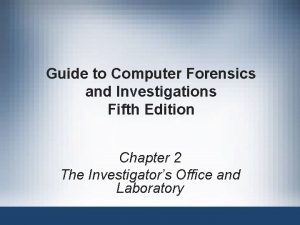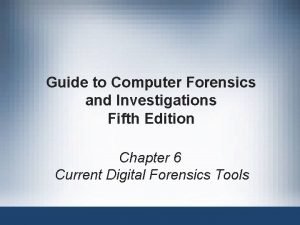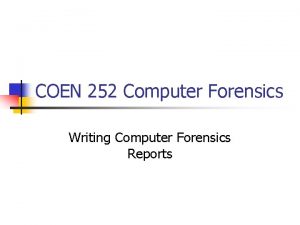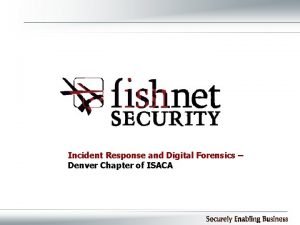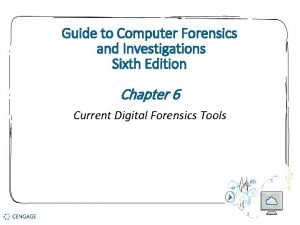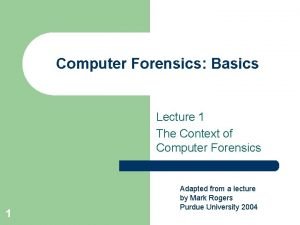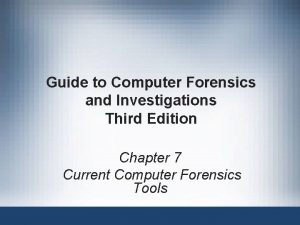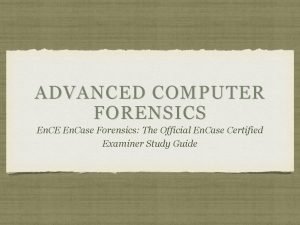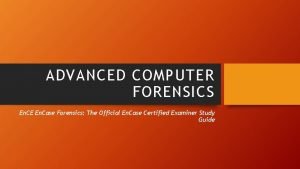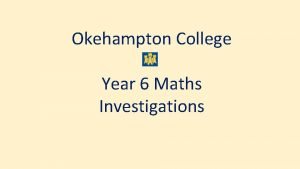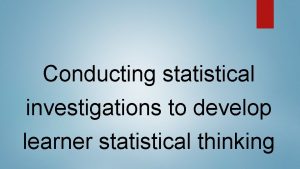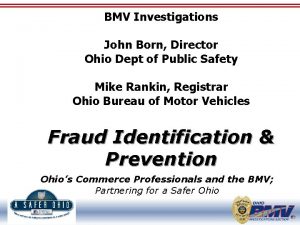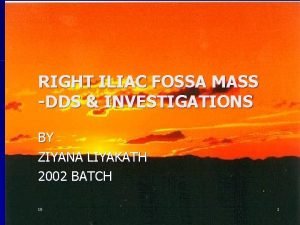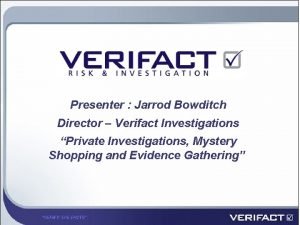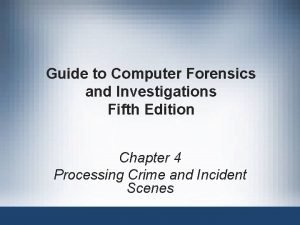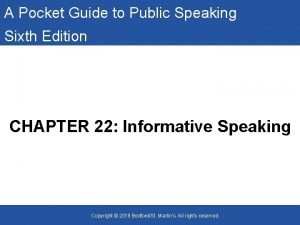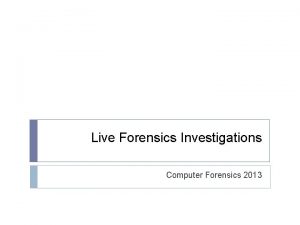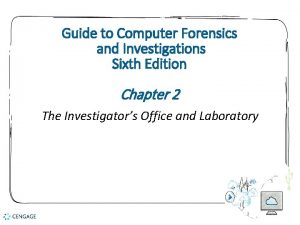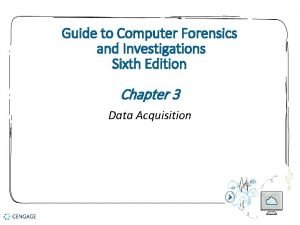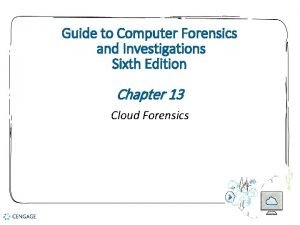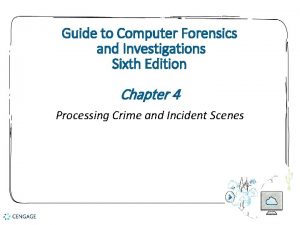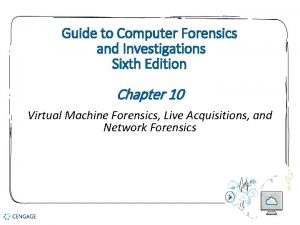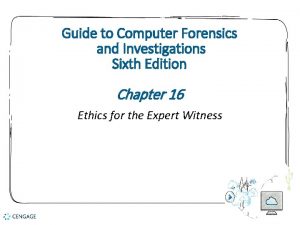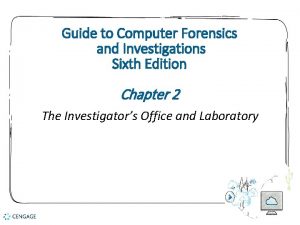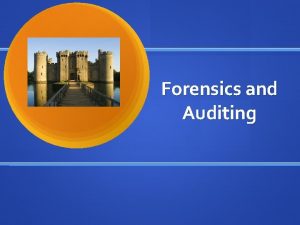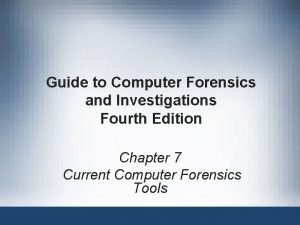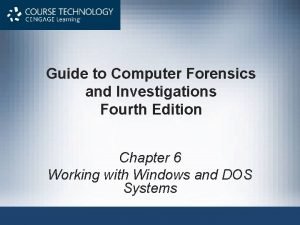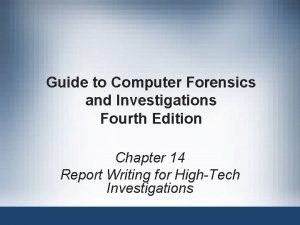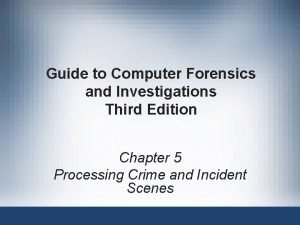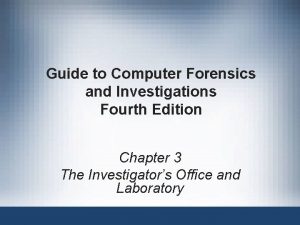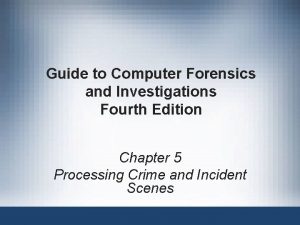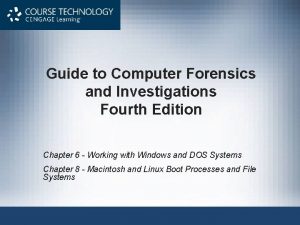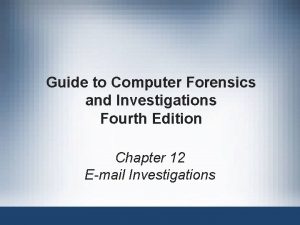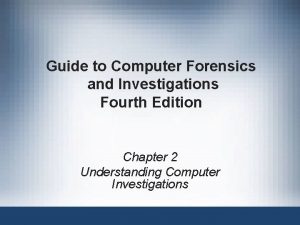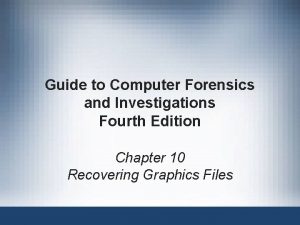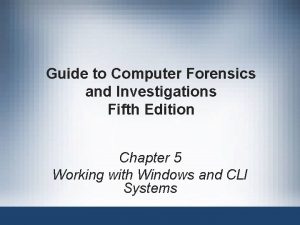Guide to Computer Forensics and Investigations Sixth Edition













































- Slides: 45

Guide to Computer Forensics and Investigations Sixth Edition Chapter 9 Digital Forensics Analysis and Investigation

Objectives • Determine what data to analyze in a digital forensics investigation • Explain tools used to validate data • Explain common data-hiding techniques © 2019 Cengage. May not be copied, scanned, or duplicated, in whole or in part, except for use as permitted in a license distributed with a certain product or service or otherwise on a password-protected website for classroom use. 2

Determining What Data to Collect and Analyze (1 of 2) • Examining and analyzing digital evidence depend on the nature of the investigation • And the amount of data to process • Scope creep - when an investigation expands beyond the original description • Because of unexpected evidence found • Attorneys may ask investigators to examine other areas to recover more evidence • Increases the time and resources needed to extract, analyze, and present evidence © 2019 Cengage. May not be copied, scanned, or duplicated, in whole or in part, except for use as permitted in a license distributed with a certain product or service or otherwise on a password-protected website for classroom use. 3

Determining What Data to Collect and Analyze (2 of 2) • Scope creep has become more common • Criminal investigations require more detailed examination of evidence just before trial • To help prosecutors fend off attacks from defense attorneys • New evidence often isn’t revealed to prosecution • It’s become more important for prosecution teams to ensure they have analyzed the evidence exhaustively before trial © 2019 Cengage. May not be copied, scanned, or duplicated, in whole or in part, except for use as permitted in a license distributed with a certain product or service or otherwise on a password-protected website for classroom use. 4

Approaching Digital Forensics Cases (1 of 4) • Begin a case by creating an investigation plan that defines the: • Goal and scope of investigation • Materials needed • Tasks to perform • The approach you take depends largely on the type of case you’re investigating • Corporate, civil, or criminal © 2019 Cengage. May not be copied, scanned, or duplicated, in whole or in part, except for use as permitted in a license distributed with a certain product or service or otherwise on a password-protected website for classroom use. 5

Approaching Digital Forensics Cases (2 of 4) • Follow these basic steps for all digital forensics investigations: • 1. For target drives, use recently wiped media that have been reformatted and inspected for viruses • 2. Inventory the hardware on the suspect’s computer, and note condition of seized computer • 3. For static acquisitions, remove original drive and check the date and time values in system’s CMOS • 4. Record how you acquired data from the suspect drive © 2019 Cengage. May not be copied, scanned, or duplicated, in whole or in part, except for use as permitted in a license distributed with a certain product or service or otherwise on a password-protected website for classroom use. 6

Approaching Digital Forensics Cases (3 of 4) • Follow these basic steps for all digital forensics investigations (cont’d): • • • 5. Process drive’s contents methodically and logically 6. List all folders and files on the image or drive 7. Examine contents of all data files in all folders 8. Recover file contents for all password-protected files 9. Identify function of every executable file that doesn’t match hash values 10. Maintain control of all evidence and findings © 2019 Cengage. May not be copied, scanned, or duplicated, in whole or in part, except for use as permitted in a license distributed with a certain product or service or otherwise on a password-protected website for classroom use. 7

Approaching Digital Forensics Cases (4 of 4) • Refining and Modifying the Investigation Plan • Even if initial plan is sound, at times you may need to deviate from it and follow evidence • Knowing the types of data to look for helps you make the best use of your time • The key is to start with a plan but remain flexible in the face of new evidence © 2019 Cengage. May not be copied, scanned, or duplicated, in whole or in part, except for use as permitted in a license distributed with a certain product or service or otherwise on a password-protected website for classroom use. 8

Using Autopsy to Analyze Data (1 of 6) • Autopsy can perform forensics analysis on the following file systems: • • Microsoft FAT, NTFS, Ex. FAT, UFS 1, and UFS 2 ISO 9660 and YAFFS 2 Mac HFS+ and HFSX Linux Ext 2 fs, Ext 3 fs, and Ext 4 fs • Autopsy can analyze data from several sources • Including image files from other vendors © 2019 Cengage. May not be copied, scanned, or duplicated, in whole or in part, except for use as permitted in a license distributed with a certain product or service or otherwise on a password-protected website for classroom use. 9

Using Autopsy to Analyze Data (2 of 6) • Autopsy can handle many formats, including: • Raw, Expert Witness, and virtual machine image files (. vdi and. vhd) • Has an indexed version of the NIST National Software Reference Library (NSRL) of MD 5 hashes • Installing NSRL Hashes in Autopsy • Need to download the latest version © 2019 Cengage. May not be copied, scanned, or duplicated, in whole or in part, except for use as permitted in a license distributed with a certain product or service or otherwise on a password-protected website for classroom use. 10

Using Autopsy to Analyze Data (3 of 6) © 2019 Cengage. May not be copied, scanned, or duplicated, in whole or in part, except for use as permitted in a license distributed with a certain product or service or otherwise on a password-protected website for classroom use. 11

Using Autopsy to Analyze Data (4 of 6) • Collecting Hash Values in Autopsy • Create a hash database of known files of interest © 2019 Cengage. May not be copied, scanned, or duplicated, in whole or in part, except for use as permitted in a license distributed with a certain product or service or otherwise on a password-protected website for classroom use. 12

Using Autopsy to Analyze Data (5 of 6) © 2019 Cengage. May not be copied, scanned, or duplicated, in whole or in part, except for use as permitted in a license distributed with a certain product or service or otherwise on a password-protected website for classroom use. 13

Using Autopsy to Analyze Data (6 of 6) © 2019 Cengage. May not be copied, scanned, or duplicated, in whole or in part, except for use as permitted in a license distributed with a certain product or service or otherwise on a password-protected website for classroom use. 14

Validating Forensic Data • Ensuring the integrity of data collected is essential for presenting evidence in court • Most forensic tools offer hashing of image files • Using advanced hexadecimal editors ensures data integrity © 2019 Cengage. May not be copied, scanned, or duplicated, in whole or in part, except for use as permitted in a license distributed with a certain product or service or otherwise on a password-protected website for classroom use. 15

Validating with Hexadecimal Editors (1 of 6) • Advanced hexadecimal editors offer features not available in digital forensics tools, such as: • Hashing specific files or sectors • With the hash value in hand • You can use a forensics tool to search for a suspicious file that might have had its name changed to look like an innocuous file • Win. Hex provides MD 5 and SHA-1 hashing algorithms © 2019 Cengage. May not be copied, scanned, or duplicated, in whole or in part, except for use as permitted in a license distributed with a certain product or service or otherwise on a password-protected website for classroom use. 16

Validating with Hexadecimal Editors (2 of 6) © 2019 Cengage. May not be copied, scanned, or duplicated, in whole or in part, except for use as permitted in a license distributed with a certain product or service or otherwise on a password-protected website for classroom use. 17

Validating with Hexadecimal Editors (3 of 6) © 2019 Cengage. May not be copied, scanned, or duplicated, in whole or in part, except for use as permitted in a license distributed with a certain product or service or otherwise on a password-protected website for classroom use. 18

Validating with Hexadecimal Editors (4 of 6) © 2019 Cengage. May not be copied, scanned, or duplicated, in whole or in part, except for use as permitted in a license distributed with a certain product or service or otherwise on a password-protected website for classroom use. 19

Validating with Hexadecimal Editors (5 of 6) • Advantage of recording hash values • You can determine whether data has changed • Block-wise hashing • A process that builds a data set of hashes of sectors from the original file • Then examines sectors on the suspect’s drive to see whether any other sectors match • If an identical hash value is found, you have confirmed that the file was stored on the suspect’s drive © 2019 Cengage. May not be copied, scanned, or duplicated, in whole or in part, except for use as permitted in a license distributed with a certain product or service or otherwise on a password-protected website for classroom use. 20

Validating with Hexadecimal Editors (6 of 6) • Using Hash Values to Discriminate Data • Access. Data has its own hashing database, Known File Filter (KFF) • KFF filters known program files from view and contains has values of known illegal files • It compares known file hash values with files on your evidence drive to see whether they contain suspicious data • Other digital forensics tools can import the NSRL database and run hash comparisons © 2019 Cengage. May not be copied, scanned, or duplicated, in whole or in part, except for use as permitted in a license distributed with a certain product or service or otherwise on a password-protected website for classroom use. 21

Validating with Digital Forensics Tools (1 of 3) • In Access. Data FTK Imager, when selecting the Expert Witness (. e 01) or SMART (. s 01) format: • Additional options for hashing all the data are available • Validation report lists MD 5 and SHA-1 hash values • Follow steps starting on page 393 to see how to use Win. Hex to hash an image file and then compare it with the original hash value FTK Imager calculated © 2019 Cengage. May not be copied, scanned, or duplicated, in whole or in part, except for use as permitted in a license distributed with a certain product or service or otherwise on a password-protected website for classroom use. 22

Validating with Digital Forensics Tools (2 of 3) © 2019 Cengage. May not be copied, scanned, or duplicated, in whole or in part, except for use as permitted in a license distributed with a certain product or service or otherwise on a password-protected website for classroom use. 23

Validating with Digital Forensics Tools (3 of 3) © 2019 Cengage. May not be copied, scanned, or duplicated, in whole or in part, except for use as permitted in a license distributed with a certain product or service or otherwise on a password-protected website for classroom use. 24

Addressing Data-Hiding Techniques • Data hiding - changing or manipulating a file to conceal information • Techniques: • • • Hiding entire partitions Changing file extensions Setting file attributes to hidden Bit-shifting Using encryption Setting up password protection © 2019 Cengage. May not be copied, scanned, or duplicated, in whole or in part, except for use as permitted in a license distributed with a certain product or service or otherwise on a password-protected website for classroom use. 25

Hiding Files by Using the OS • One of the first techniques to hide data: • Changing file extensions • Advanced digital forensics tools check file headers • Compare the file extension to verify that it’s correct • If there’s a discrepancy, the tool flags the file as a possible altered file • Another hiding technique • Selecting the Hidden attribute in a file’s Properties dialog box © 2019 Cengage. May not be copied, scanned, or duplicated, in whole or in part, except for use as permitted in a license distributed with a certain product or service or otherwise on a password-protected website for classroom use. 26

Hiding Partitions (1 of 4) • By using the Windows diskpart remove letter command • You can unassign the partition’s letter, which hides it from view in File Explorer • To unhide, use the diskpart assign letter command • Other disk management tools: • IM-Magic, Ease. US Partition Master, and Linux Grand Unified Bootloader (GRUB) © 2019 Cengage. May not be copied, scanned, or duplicated, in whole or in part, except for use as permitted in a license distributed with a certain product or service or otherwise on a password-protected website for classroom use. 27

Hiding Partitions (2 of 4) • To detect whether a partition has been hidden • Account for all disk space when examining an evidence drive • Analyze any disk areas containing space you can’t account for • Many digital forensics tools can detect and view a hidden partition © 2019 Cengage. May not be copied, scanned, or duplicated, in whole or in part, except for use as permitted in a license distributed with a certain product or service or otherwise on a password-protected website for classroom use. 28

Hiding Partitions (3 of 4) © 2019 Cengage. May not be copied, scanned, or duplicated, in whole or in part, except for use as permitted in a license distributed with a certain product or service or otherwise on a password-protected website for classroom use. 29

Hiding Partitions (4 of 4) © 2019 Cengage. May not be copied, scanned, or duplicated, in whole or in part, except for use as permitted in a license distributed with a certain product or service or otherwise on a password-protected website for classroom use. 30

Marking Bad Clusters • A data-hiding technique used in FAT file systems is placing sensitive or incriminating data in free or slack space on disk partition clusters • Involves using old utilities such as Norton Disk. Edit • Can mark good clusters as bad clusters in the FAT table so the OS considers them unusable • Only way they can be accessed from the OS is by changing them to good clusters with a disk editor • Disk. Edit runs only in MS-DOS and can access only FAT-formatted disk media © 2019 Cengage. May not be copied, scanned, or duplicated, in whole or in part, except for use as permitted in a license distributed with a certain product or service or otherwise on a password-protected website for classroom use. 31

Bit-Shifting (1 of 4) • Some users use a low-level encryption program that changes the order of binary data • Makes altered data unreadable to secure a file, users run an assembler program (also called a “macro”) to scramble bits • Run another program to restore the scrambled bits to their original order • Bit shifting changes data from readable code to data that looks like binary executable code • Win. Hex and Hex Workshop includes a feature for shifting bits © 2019 Cengage. May not be copied, scanned, or duplicated, in whole or in part, except for use as permitted in a license distributed with a certain product or service or otherwise on a password-protected website for classroom use. 32

Bit-Shifting (2 of 4) © 2019 Cengage. May not be copied, scanned, or duplicated, in whole or in part, except for use as permitted in a license distributed with a certain product or service or otherwise on a password-protected website for classroom use. 33

Bit-Shifting (3 of 4) © 2019 Cengage. May not be copied, scanned, or duplicated, in whole or in part, except for use as permitted in a license distributed with a certain product or service or otherwise on a password-protected website for classroom use. 34

Bit-Shifting (4 of 4) © 2019 Cengage. May not be copied, scanned, or duplicated, in whole or in part, except for use as permitted in a license distributed with a certain product or service or otherwise on a password-protected website for classroom use. 35

Understanding Steganalysis Methods (1 of 3) • Steganography - comes from the Greek word for “hidden writing” • Hiding messages in such a way that only the intended recipient knows the message is there • Steganalysis - term for detecting and analyzing steganography files • Digital watermarking - developed as a way to protect file ownership • Usually not visible when used for steganography © 2019 Cengage. May not be copied, scanned, or duplicated, in whole or in part, except for use as permitted in a license distributed with a certain product or service or otherwise on a password-protected website for classroom use. 36

Understanding Steganalysis Methods (2 of 3) • A way to hide data is to use steganography tools • Many are freeware or shareware • Insert information into a variety of files • If you encrypt a plaintext file with PGP and insert the encrypted text into a steganography file • Cracking the encrypted message is extremely difficult © 2019 Cengage. May not be copied, scanned, or duplicated, in whole or in part, except for use as permitted in a license distributed with a certain product or service or otherwise on a password-protected website for classroom use. 37

Understanding Steganalysis Methods (3 of 3) • Steganalysis methods • • • Stego-only attack Known cover attack Known message attack Chosen stego attack Chosen message attack © 2019 Cengage. May not be copied, scanned, or duplicated, in whole or in part, except for use as permitted in a license distributed with a certain product or service or otherwise on a password-protected website for classroom use. 38

Examining Encrypted Files • To decode an encrypted file • Users supply a password or passphrase • Many encryption programs use a technology called “key escrow” • Designed to recover encrypted data if users forget their passphrases or if the user key is corrupted after a system failure • Key sizes of 128 bits to 4096 bits make breaking them nearly impossible with current technology © 2019 Cengage. May not be copied, scanned, or duplicated, in whole or in part, except for use as permitted in a license distributed with a certain product or service or otherwise on a password-protected website for classroom use. 39

Recovering Passwords (1 of 4) • Password-cracking tools are available for handling password-protected data or systems • Some are integrated into digital forensics tools • Stand-alone tools: • • • Last Bit Access. Data PRTK ophcrack John the Ripper Passware © 2019 Cengage. May not be copied, scanned, or duplicated, in whole or in part, except for use as permitted in a license distributed with a certain product or service or otherwise on a password-protected website for classroom use. 40

Recovering Passwords (2 of 4) • Brute-force attacks • Use every possible letter, number, and character found on a keyboard • This method can require a lot of time and processing power • Dictionary attack • Uses common words found in the dictionary and tries them as passwords • Most use a variety of languages © 2019 Cengage. May not be copied, scanned, or duplicated, in whole or in part, except for use as permitted in a license distributed with a certain product or service or otherwise on a password-protected website for classroom use. 41

Recovering Passwords (3 of 4) • With many programs, you can build profiles of a suspect to help determine his or her password • Many password-protected OSs and application store passwords in the form of MD 5 or SHA hash values • A brute-force attack requires converting a dictionary password from plaintext to a hash value • Requires additional CPU cycle time © 2019 Cengage. May not be copied, scanned, or duplicated, in whole or in part, except for use as permitted in a license distributed with a certain product or service or otherwise on a password-protected website for classroom use. 42

Recovering Passwords (4 of 4) • Rainbow table • A file containing the hash values for every possible password that can be generated from a computer’s keyboard • No conversion necessary, so it is faster than a brute-force or dictionary attack • Salting passwords • Alters hash values and makes cracking passwords more difficult © 2019 Cengage. May not be copied, scanned, or duplicated, in whole or in part, except for use as permitted in a license distributed with a certain product or service or otherwise on a password-protected website for classroom use. 43

Summary (1 of 2) • Examining and analyzing digital evidence depend on the nature of the investigation and the amount of data to process • General procedures: • Wipe and prepare target drives, document all hardware components on the suspect’s computer, check date and time values in the suspect’s computer’s CMOS, acquire data and document steps, list all folders and files, attempt to open passwordprotected files, determine function of executable files, and document steps © 2019 Cengage. May not be copied, scanned, or duplicated, in whole or in part, except for use as permitted in a license distributed with a certain product or service or otherwise on a password-protected website for classroom use. 44

Summary (2 of 2) • Advanced digital forensics tools have features such as indexing text data, making keyword searches faster • A critical aspect of digital forensics is validating digital evidence • Ensuring the integrity of data you collect is essential for presenting evidence in court • Data hiding involves changing or manipulating a file to conceal information • Three ways to recover passwords: • Dictionary attacks • Brute-force attacks • Rainbows tables © 2019 Cengage. May not be copied, scanned, or duplicated, in whole or in part, except for use as permitted in a license distributed with a certain product or service or otherwise on a password-protected website for classroom use. 45
 Marking bad clusters data hiding technique
Marking bad clusters data hiding technique Forensics
Forensics Guide to computer forensics and investigations
Guide to computer forensics and investigations Computer architecture a quantitative approach sixth edition
Computer architecture a quantitative approach sixth edition Computer architecture a quantitative approach sixth edition
Computer architecture a quantitative approach sixth edition Computer architecture a quantitative approach sixth edition
Computer architecture a quantitative approach sixth edition The sixth sheik's sixth sheep's sick
The sixth sheik's sixth sheep's sick The sixth sick sheik's sixth sheep's sick lyrics
The sixth sick sheik's sixth sheep's sick lyrics Biochemistry sixth edition
Biochemistry sixth edition Automotive technology sixth edition
Automotive technology sixth edition Automotive technology sixth edition
Automotive technology sixth edition Apa sixth edition
Apa sixth edition Precalculus sixth edition
Precalculus sixth edition Principles of economics sixth edition
Principles of economics sixth edition Forensic science fundamentals and investigations chapter 6
Forensic science fundamentals and investigations chapter 6 Computer forensics report template
Computer forensics report template Computer forensics denver
Computer forensics denver Building a forensic workstation
Building a forensic workstation Objectives of computer forensics
Objectives of computer forensics Computer crime
Computer crime Computer forensics tool testing
Computer forensics tool testing Tasks performed by computer forensics tools
Tasks performed by computer forensics tools Dr qaira anum
Dr qaira anum Advanced computer forensics
Advanced computer forensics Fastbloc
Fastbloc Mis chapter 6
Mis chapter 6 Chapter 1
Chapter 1 Why aren t descriptive investigations repeatable
Why aren t descriptive investigations repeatable Year 6 maths investigations
Year 6 maths investigations Craigslist wayne
Craigslist wayne Statistical average crossword
Statistical average crossword Statistical investigations examples
Statistical investigations examples Bmv toledo ohio heatherdowns
Bmv toledo ohio heatherdowns Conclusion in scientific method
Conclusion in scientific method Child protective investigations pasco county
Child protective investigations pasco county Chs investigations
Chs investigations Appendiculolith
Appendiculolith Jarrod bowditch
Jarrod bowditch 3 weeks pregnant ultrasound
3 weeks pregnant ultrasound Investigations
Investigations Chs investigations
Chs investigations Florida real estate broker's guide 6th edition
Florida real estate broker's guide 6th edition Florida real estate broker's guide
Florida real estate broker's guide Pocket guide to public speaking
Pocket guide to public speaking Guide to wireless communications
Guide to wireless communications Prehospital emergency care 11th edition study guide
Prehospital emergency care 11th edition study guide

